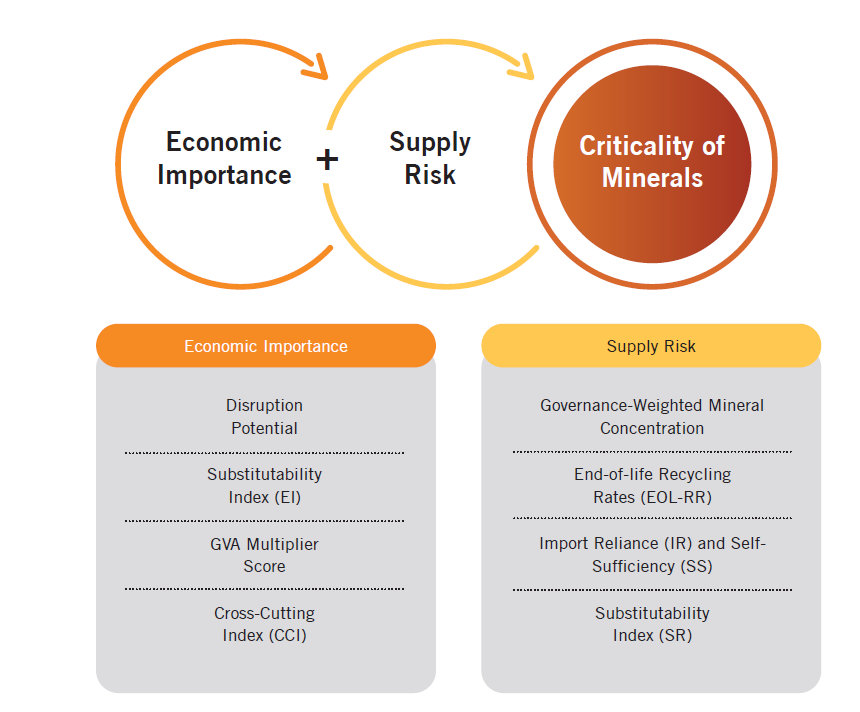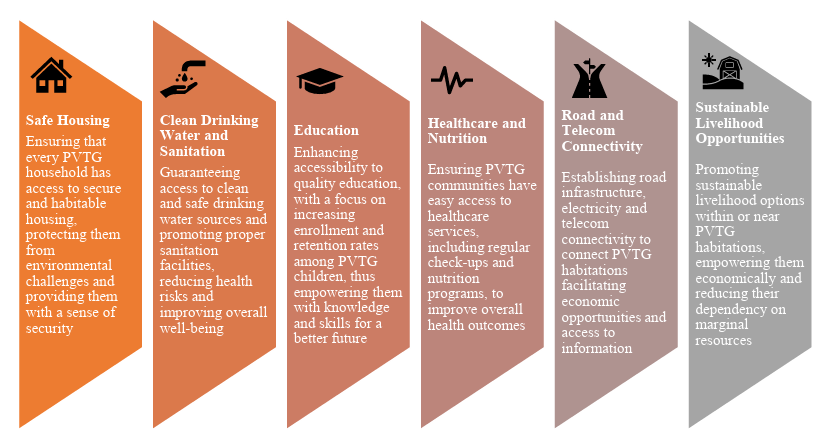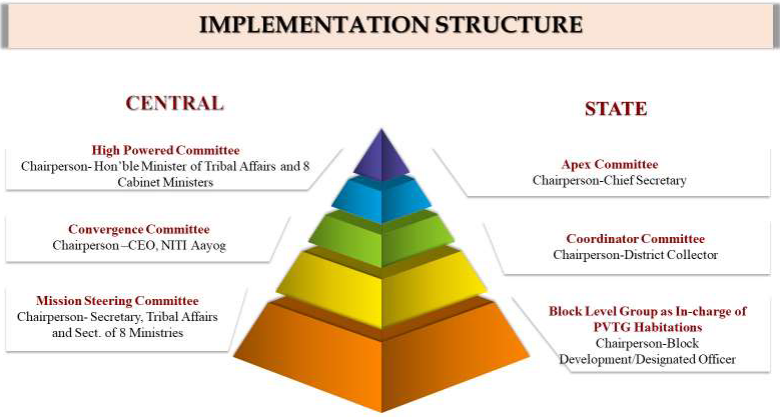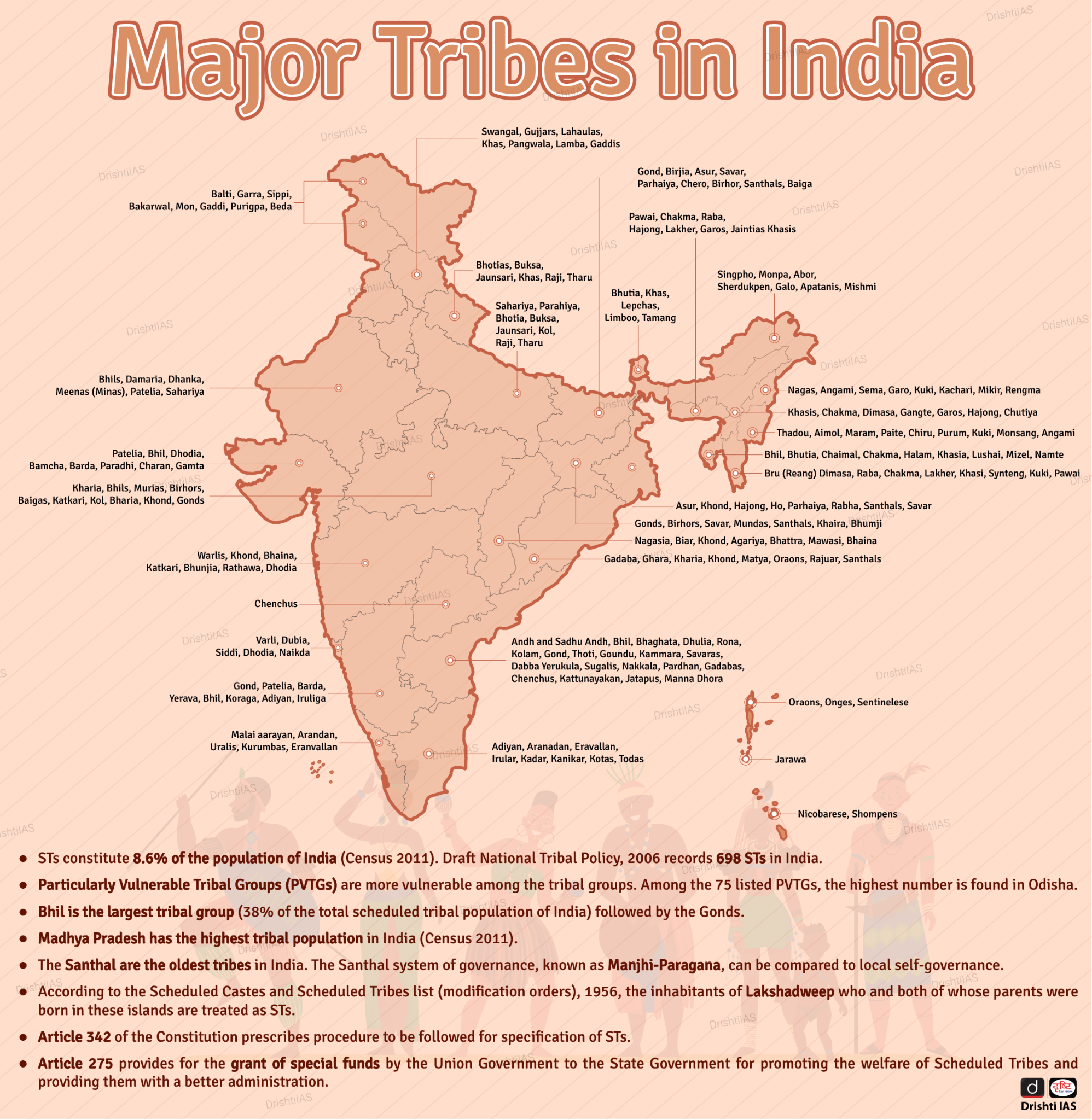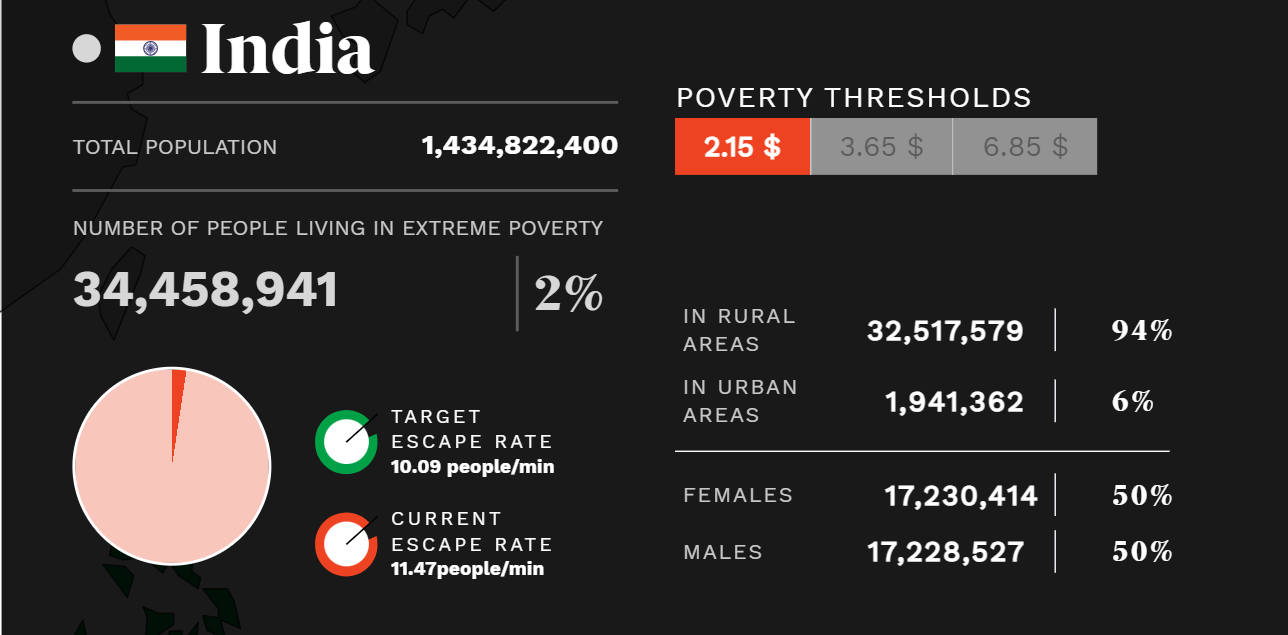Surge in Demand of Copper
For Prelims: Properties and Applications of Copper, Mining Methods of Copper, Copper Deposits in India, Hindustan Copper Limited, Chalcopyrite, Bornite, Chalcocite
For Mains: India’s Copper Appetite, Copper as an Economic Barometer.
Why in News?
As demand for copper grew by 16% yearly-on-year in FY23, policymakers and corporations have increasingly turned their attention to the critical role of copper in spurring economic growth.
What are the Key Points Related to Copper?
- About: Copper is a malleable, ductile metal known for its excellent heat and electricity conductivity. It possesses corrosion resistance and antimicrobial properties.
- Malleability refers to the ability of a material to be pressed, or rolled into thin sheets without breaking or cracking.
- Ductility is the property of a material that allows it to be stretched or drawn out into a thin wire without losing its strength or breaking.
- Applications: It is widely utilised in construction, consumer durables, transportation, and industrial manufacturing.
- It is also Integral to clean energy technologies such as solar panels, electric vehicles (EVs), and energy-efficient motors.
- It is a 100% recyclable metal (allows for a circular economy).
- Occurrence and Composition: It is naturally found in various forms in the Earth’s crust.
- It can be found in sulphide deposits (as chalcopyrite, bornite, chalcocite, covellite), in carbonate deposits (as azurite and malachite), in silicate deposits (as chrysycolla and dioptase) and as pure native copper.
- Most commercial copper ore deposits contain an average grade of 0.8% copper, while copper ore in India has an average copper content of around 1%.
- Mining Methods: There are two primary methods of copper mining: open-pit and underground mining.
- Open-pit mining dominates, constituting 80% of global copper mining operations.
- Copper Deposits in India: Mainly located in Singhbhum (Jharkhand), Balaghat (Madhya Pradesh), and Jhunjhunu and Alwar (Rajasthan) districts.
- Minor deposits are found in Agnigundala (Andhra Pradesh), Chitradurg and Hasan (Karnataka), and South Arcot (Tamil Nadu) districts.
- India’s Copper Appetite: India's demand for copper is soaring due to rising infrastructure projects, renewable energy initiatives, and urbanisation.
- Despite this, the country heavily relies on copper imports due to limited domestic reserves.
- To address this, the government is promoting investments in smelters and refineries while Indian companies are acquiring copper mines abroad to secure a stable supply and reduce dependence on international markets.
- Recently, the Ministry of Mines has proposed sending an Indian industry delegation to copper-rich Zambia to discuss potential copper exploration and mining projects in the southern African country
- Recognizing copper's criticality, the government has included it in its list of critical minerals, highlighting the need to reduce import dependence.
- Hindustan Copper Limited (HCL): Established in 1967 under the Companies Act, It is a Miniratna Category-I enterprise operating under the Ministry of Mines, Government of India.
- It was formed to consolidate all copper exploration and exploitation projects from the National Mineral Development Corporation Ltd.
- HCL is India's only vertically integrated copper producing company.
- Copper's Key Importance:
- Copper as an Economic Barometer: Copper prices reflect demand/supply dynamics, monetary markets, and speculation, making it a global economic indicator.
- Unlike sector-specific commodities, copper is integral across all economic sectors.
- Copper for Energy Efficiency: Copper plays a vital role in promoting energy efficiency in buildings.
- Its excellent thermal and electrical conductivity make it ideal for wiring, heat exchangers, and roofing, leading to reduced energy consumption for heating, cooling, and lighting.
- By minimising energy losses throughout a building's lifespan, copper contributes to a more sustainable future.
- Copper as an Economic Barometer: Copper prices reflect demand/supply dynamics, monetary markets, and speculation, making it a global economic indicator.
Note
- Chile is the top copper producer in the world, with 27% of global copper production. In addition, the country is home to the two largest mines in the world, Escondido and Collahuasi.
UPSC Civil Services Examination Previous Year Question (PYQ)
Prelims
Q. With reference to the mineral resources of India, consider the following pairs: (2010)
Mineral : 90% Natural sources in
- Copper : Jharkhand
- Nickel : Orissa
- Tungsten : Kerala
Which of the pairs given above is/are correctly matched?
(a) 1 and 2 only
(b) 2 only
(c) 1 and 3 only
(d) 1, 2 and 3
Ans: (b)
Mains
Q. Despite India being one of the countries of Gondwanaland, its mining industry contributes much less to its Gross Domestic Product (GDP) in percentage. Discuss. (2021)
PM-JANMAN Housing for PVTGs
For Prelims: Particularly Vulnerable Tribal Groups, PM-JANMAN Scheme, Janjatiya Gaurav Divas, Viksit Bharat Sankalp Yatra, PM PVTG Mission, PM Gati Shakti portal
For Mains: Sustainable Livelihoods For PVTGs. Welfare schemes for vulnerable sections of the population, Government Policies & Interventions
Why in News?
The housing component of Pradhan Mantri Janjati Adivasi Nyay Maha Abhiyaan (PM-JANMAN), aimed at providing housing for Particularly Vulnerable Tribal Groups (PVTGs), faces significant challenges hindering its smooth implementation.
What are the Challenges Hindering the implementation of PM-JANMAN?
- Data Discrepancies:
- Discrepancies have emerged between the data provided by the Centre and the figures identified by the states. This disparity in data poses a significant hurdle in accurately identifying potential beneficiaries.
- The Centre relied on the PM Gati Shakti portal for estimating the total population of 75 PVTG, resulting in varying figures.
- The estimates jumped from 28 lakh to 44.64 lakhs within a short span, indicating inconsistencies in data collection.
- State governments were given a limited timeframe to conduct their surveys, leading to rushed and incomplete data collection processes.
- States like Kerala, Madhya Pradesh, and Tripura have raised concerns about beneficiaries being left out due to discrepancies in the data.
- For example, Madhya Pradesh has found 50,000 additional eligible households outside the villages notified by the Centre.
- States like Kerala, Madhya Pradesh, and Tripura have raised concerns about beneficiaries being left out due to discrepancies in the data.
- Slow Progress:
- The simultaneous collection of beneficiary data and project implementation has led to delays in the housing component of PM-JANMAN. Out of the targeted 5 lakh houses, only 1.59 lakh have been sanctioned, significantly missing the initial target.
- Election Year Pressure:
- The scheme is being implemented at a rapid pace, especially with the upcoming General Elections 2024. The urgency to show progress may compromise thorough planning and execution, potentially affecting the quality and inclusivity of the housing distribution.
- Geographical Challenges:
- Identifying eligible beneficiaries in remote and inaccessible areas poses logistical challenges. Lack of infrastructure and communication networks in tribal regions may impede data collection efforts and delay the implementation of the housing scheme.
- Dynamic Population Dynamics:
- Tribal populations, especially PVTGs, often exhibit migratory patterns in search of employment and livelihood opportunities.
- This dynamic nature of population movement complicates the task of accurately estimating and identifying eligible beneficiaries, requiring adaptive strategies to ensure comprehensive coverage.
- Tribal populations, especially PVTGs, often exhibit migratory patterns in search of employment and livelihood opportunities.
What is PM-JANMAN?
- About:
- PM-JANMAN, launched on 15th November 2023, on Janjatiya Gaurav Diwas, focuses on 11 critical interventions through 9 ministries to improve the socio-economic welfare of PVTGs.
- PM-JANMAN comprises Central Sector and Centrally Sponsored Schemes to improve the socio-economic conditions of PVTGs.
- The scheme has a total outlay of Rs 24,104 crore to be spent over a three-year period, of which nearly 80% is only for the construction of houses and roads.
- An allocation of Rs 15,000 crore has been made for the next three years under the Development Action Plan for the Scheduled Tribes (DAPST) to implement the housing component of PM-JANMAN.
- Vision:
- PM-JANMAN envisions improving the socio-economic status of PVTGs by bridging gaps in health, education, and livelihoods.
- The focus is on enhancing basic infrastructure in PVTG communities, habitations, and families, aligning with existing schemes of nine Ministries/Departments.
- PM-JANMAN envisions improving the socio-economic status of PVTGs by bridging gaps in health, education, and livelihoods.
- Scope:
- The mission's primary scope is to comprehensively enhance the living conditions of PVTG by ensuring they have access to essential amenities and services. This includes:
- Foundational Features of PM-JANMAN:
- Inter-Ministerial Convergence:
- In a unique approach, 9 Ministries of the Government of India collaborate under the leadership of the Ministry of Tribal Affairs.
- Each Ministry oversees the implementation of its schemes while collectively ensuring comprehensive coverage and welfare of the most vulnerable tribal communities.
- In a unique approach, 9 Ministries of the Government of India collaborate under the leadership of the Ministry of Tribal Affairs.
- Alignment of Schemes/Programs:
- Existing norms of schemes within concerned Ministries are modified to address the specific needs of tribal communities.
- Revised guidelines are issued to ensure that the objectives of PM-JANMAN are effectively integrated into ongoing programs.
- Existing norms of schemes within concerned Ministries are modified to address the specific needs of tribal communities.
- Coverage of the Scheme:
- PM-JANMAN aims to reach 75 PVTGs residing in 18 states and 1 UT who continue to lag in socio-economic indicators of educational, health and livelihood.
- The focus is on providing holistic support to tribal communities across various domains, including health, education, and livelihoods.
- PM-JANMAN aims to reach 75 PVTGs residing in 18 states and 1 UT who continue to lag in socio-economic indicators of educational, health and livelihood.
- Identification of Gaps:
- Through physical surveys conducted by state governments, gaps in each intervention area are identified.
- Data is updated on the PM Gati-shakti Portal, enabling cross-verification by relevant Ministries and State Departments to ensure accuracy and completeness.
- Through physical surveys conducted by state governments, gaps in each intervention area are identified.
- Provision of Funds:
- The source of funds for each of the 11 interventions is the DAPST grants allocated to respective Ministries/Departments under their identified schemes covered by PM-JANMAN.
- Flexibility is provided under the DAPST mechanism to ensure dedicated funds availability for the successful implementation of the mission.
- The source of funds for each of the 11 interventions is the DAPST grants allocated to respective Ministries/Departments under their identified schemes covered by PM-JANMAN.
- Reward Mechanism:
- Performance evaluation is conducted through the ranking of districts based on monthly incremental changes in performance indicators.
- The purpose is to foster a sense of competition among district teams, with the top three districts and Ministries recognised and rewarded for their outstanding performance.
- Inter-Ministerial Convergence:
Note
- The DAPST is a strategy for tribal development in India. The Ministry of Tribal Affairs and 41 other ministries and departments allocate funds to tribal development projects under DAPST.
- These projects include education, health, agriculture, irrigation, roads, housing, electrification, and employment.
What are the other Initiatives for PVTGs?
Way Forward
- Implement a standardised data collection methodology to ensure data accuracy.
- Implement streamlined processes to expedite data collection and project execution without compromising quality.
- Engage tribal communities in the scheme's planning and execution to enhance inclusivity and effectiveness.
- Invest in infrastructure and communication networks in tribal regions to facilitate data collection and scheme implementation.
- Develop adaptive strategies to account for dynamic population movements among tribal groups and ensure comprehensive coverage of eligible beneficiaries.
- Provide training and capacity-building programs for stakeholders involved in data collection and scheme implementation to enhance efficiency and effectiveness.\\
UPSC Civil Services Examination, Previous Year Question (PYQ)
Prelims
Q.1 Consider the following statements about Particularly Vulnerable Tribal Groups (PVTGs) in India: (2019)
- PVTGs reside in 18 States and one Union Territory.
- A stagnant or declining population is one of the criteria for determining PVTG status.
- There are 95 PVTGs officially notified in the country so far.
- Irular and Konda Reddi tribes are included in the list of PVTGs.
Which of the statements given above are correct?
(a) 1, 2 and 3
(b) 2, 3 and 4
(c) 1, 2 and 4
(d) 1, 3 and 4
Ans: C
Q.2 Consider the following pairs: (2013)
| Tribe | State | |
| 1. | Limboo (Limbu) | Sikkim |
| 2. | Karbi | Himachal Pradesh |
| 3. | Dongaria Kondh | Odisha |
| 4. | Bonda | Tamil Nadu |
Which of the above pairs are correctly matched?
(a) 1 and 3 only
(b) 2 and 4 only
(c) 1, 3 and 4 only
(d) 1, 2, 3 and 4
Ans: (a)
Mains:
Q. What are the two major legal initiatives by the State since Independence addressing discrimination against Scheduled Tribes (STs)? (2017)
Q. Why are the tribals in India referred to as ‘the Scheduled Tribes’? Indicate the major provisions enshrined in the Constitution of India for their upliftment. (2016)
Genome India Project
For Prelims: Genome India Project, Whole-genome sequencing, Applications of Genome Sequencing.
For Mains: Procedure of Genome Sequencing, Goal of Genome India Project.
Why in News?
The Genome India Project, a project funded and coordinated by the Department of Biotechnology (DBT), announced that it had finished sequencing 10,000 Indian genomes.
What is the Genome India Project?
- DBT initiated the ambitious Genome India Project (GIP) on 3rd January 2020. It is led by the Centre for Brain Research at the Indian Institute of Science, Bengaluru, and involves collaboration with 20 institutions.
- The project involves whole-genome sequencing and data analysis of 10,000 individuals to understand disease nature in the Indian population and develop predictive diagnostic markers.
- India's population of 1.3 billion comprises over 4,600 population groups, many of which are endogamous (Matrimony in Close Ethnic Groups), contributing to genetic diversity and disease-causing mutations.
- This huge dataset of 8 petabytes will be stored at the Indian Biological Data Centre (IBDC) in Faridabad.
- Inaugurated in 2022, the IBDC is India's first national repository for life science data.
- Significance:
- An India-specific genetic database is crucial because mutations like MYBPC3, linked to early cardiac arrest, are more prevalent locally than globally, affecting 4.5% of the Indian population.
- India, boasting the world's largest genetic laboratory, plays a pivotal role in driving the country's burgeoning biology sector, which has seen exponential growth from USD 10 billion in 2014 to over USD 130 billion in 2024, shaping India's future trajectory.
Note
The first whole human genome was sequenced with the collaboration of an international team. It took 13 years and $3 billion, and was completed in 2003. India announced its first complete human genome in 2009.
- However, now, it takes only about 5 days to sequence an entire human genome and perform all the quality checks.
What is Genome Sequencing?
- Gene and DNA: DNA (Deoxyribonucleic acid) is the molecule that carries the genetic instructions for the development, functioning, growth, and reproduction of all known living organisms and many viruses.
- Genes are specific segments of DNA that contain the instructions for producing proteins, which are essential for various biological functions.
- Genome: The genome represents the entirety of an organism's hereditary information, serving as a biological instruction manual inherited from parents.
- Composed of four nucleotide bases: adenine (A), cytosine (C), guanine (G), and thymine (T), the genome contains approximately 3 billion base pairs in humans.
- This complex sequence encodes essential information governing an individual's physical characteristics, susceptibility to diseases, and other biological traits.
- Genome Sequencing: Genome sequencing is the process of determining the precise order of nucleotides within an organism's genome.
- Whole genome sequencing is a laboratory procedure that determines the order of all four bases in the genome of an organism in one process.
- Procedure of Genome Sequencing:
- Firstly, the researchers extract DNA from a sample, typically obtained from blood.
- Then, the DNA is fragmented into smaller, more manageable pieces, which are then tagged with fluorescent markers.
- These tagged fragments undergo sequencing using specialised equipment known as DNA sequencers, which read the sequence of nucleotide bases.
- Finally, computational algorithms are employed to reconstruct the complete genetic sequence from the generated data, providing valuable insights into the individual's genetic makeup.
- Applications:
- Biomedical Research: Genome sequencing aids in understanding the genetic basis of diseases, identifying disease-causing mutations, and discovering potential drug targets.
- It helps researchers study genetic variations associated with complex diseases such as cancer, diabetes, and neurological disorders.
- Pharmacogenomics: Genome sequencing helps in predicting how individuals will respond to different drugs based on their genetic makeup.
- This information can optimise drug selection, dosage, and treatment strategies leading to more effective and personalised therapies.
- Agricultural Genomics: Genome sequencing is utilised in crop improvement programs to identify genes responsible for desirable traits such as disease resistance, yield, and nutritional content.
- It aids in breeding efforts to develop improved crop varieties with enhanced agronomic traits.
- Evolutionary Biology: Genome sequencing provides insights into the evolutionary history and relationships among species.
- It helps in studying genetic diversity, population dynamics, and evolutionary adaptations in different organisms.
- Conservation Biology: Genome sequencing assists in conservation efforts by assessing genetic diversity, identifying endangered species, and developing strategies for species preservation and management.
- Biomedical Research: Genome sequencing aids in understanding the genetic basis of diseases, identifying disease-causing mutations, and discovering potential drug targets.
UPSC Civil Services Examination, Previous Year Questions (PYQs)
Q1. With reference to agriculture in India, how can the technique of ‘genome sequencing’, often seen in the news, be used in the immediate future? (2017)
- Genome sequencing can be used to identify genetic markers for disease resistance and drought tolerance in various crop plants.
- This technique helps in reducing the time required to develop new varieties of crop plants.
- It can be used to decipher the host-pathogen relationships in crops.
Select the correct answer using the code given below:
(a) 1 only
(b) 2 and 3 only
(c) 1 and 3 only
(d) 1, 2 and 3
Ans: (d)
World Poverty Clock
Why in News?
According to the latest data from the World Poverty Clock, India has successfully reduced the proportion of its population living in 'extreme poverty' to below 3%.
- It signifies a substantial step towards accomplishing the first of the 17 Sustainable Development Goals (SDGs) set by the United Nations, with the target year of 2030.
What are the Key Findings of the World Poverty Clock?
- About:
- The World Poverty Clock tracks real-time poverty estimates until 2030 for almost all countries, monitoring progress toward ending extreme poverty.
- The Clock shows the worldwide number of people in extreme poverty, sorting them by age, gender, and rural or urban residency, capturing both those escaping poverty and those falling into it every second.
- The escape rate calculates the current rate of poverty reduction in the world.
- It is backed by the International Fund for Agricultural Development (IFAD) and Germany's Federal Ministry for Economic Cooperation and Development.
- Methodology and Key Findings:
- It computes poverty rates by considering income levels, with the poverty threshold established at USD 2.15 per day.
- The USD 2.15-a-day poverty line, reflecting national poverty lines in some of the poorest countries, is commonly known as the extreme poverty line.
- It is used to monitor progress towards the World Bank's goal of reducing the share of people living in extreme poverty to less than 3% by 2030.
- The population in India experiencing extreme poverty declined to approximately 3.44 crore in 2024 from 4.69 crore in 2022, accounting for 2.4% of the total population.
- These figures confirm a claim by the CEO of NITI Aayog that less than 5% of Indians are projected to be below the poverty line, with extreme destitution nearly eradicated, based on the Household Consumption Expenditure Survey (HCES), 2022-23.
- It computes poverty rates by considering income levels, with the poverty threshold established at USD 2.15 per day.
- Other Global Targets:
- SDG target 1.1 aims for global poverty eradication by 2030, setting the ambitious goal for all countries, regions, and groups to reach zero poverty at the same international poverty line.
- Niti Aayog Recent Paper On Poverty:
- A recent NITI Aayog discussion paper revealed a significant reduction in multidimensional poverty in India, dropping from 29.17% in 2013-14 to 11.28% in 2022-23, leading to 24.82 crore individuals escaping multidimensional poverty over the 9-year period.
- The paper analysed multidimensional poverty trends in India from 2005-06 to 2022-23, using National Family Health Survey (NFHS) data and projection methods for years without NFHS data.
Read More: Household Consumption Expenditure Survey 2022-23
UPSC Civil Services Examination, Previous Year Question:
Prelims
Q. In a given year in India, official poverty lines are higher in some States than in others because (2019)
(a) poverty rates vary from State to State
(b) price levels vary from State to State
(c) Gross State Product varies from State to State
(d) quality of public distribution varies from State to State
Ans: (b)
Q. With reference to the provisions made under the National Food Security Act, 2013, consider the following statements: (2018)
- The families coming under the category of ‘below poverty line (BPL)’ only are eligible to receive subsidised food grains.
- The eldest woman in a household, of age 18 years or above, shall be the head of the household for the purpose of issuance of a ration card.
- Pregnant women and lactating mothers are entitled to a ‘take-home ration’ of 1600 calories per day during pregnancy and for six months thereafter.
Which of the statements given above is/are correct?
(a) 1 and 2 only
(b) 2 only
(c) 1 and 3 only
(d) 3 only
Ans: (b)
Mains:
Q.1 COVID-19 pandemic accelerated class inequalities and poverty in India. Comment. (2020)
Q.2 ‘Despite implementation of various programmes for eradication of poverty by the government in India, poverty is still existing’. Explain by giving reasons. (2018)
FIR and General Diary
Why in News?
The Supreme Court(SC) of India in the case Shailesh Kumar v. State of UP (now State of Uttarakhand) 2024 has clarified the legal position regarding the registration of First Information Reports (FIRs) and General Diary entries by the police.
- The apex court has held that information disclosing the commission of a cognisable offence needs to be recorded as an FIR in the designated FIR book, rather than being documented in the General Diary maintained by the Police under the Police Act, 1861.
- The court emphasised that a General Diary entry cannot precede the registration of an FIR unless a preliminary inquiry is deemed necessary.
What is an FIR?
- A first information report (FIR) is a written document prepared by the police when they receive information about the commission of a cognisable offence.
- A cognisable offence is one in which the police can arrest a person without a warrant.
- The term FIR is not defined in the Indian Penal Code (IPC), Code of Criminal Procedure (CrPC), 1973, or in any other law, but in police regulations or rules, information recorded under Section 154 of CrPC is known as First Information Report (FIR).
- that FIR registration is mandatory for cognizable offences under Section 154 of the CrPC. Additionally, it emphasised
- Exceptions to the Rule of Registering an FIR: The SC ruling in Lalita Kumari v.Government of Uttar Pradesh & Others, (2014) held that FIR registration is mandatory for cognizable offences under Section 154 of the CrPC. Additionally, it emphasised that in certain cases, a preliminary inquiry may be necessary before registering an FIR. These cases are:
- Matrimonial/family disputes
- Commercial offences
- Medical negligence cases
- Corruption cases
- Cases where there is abnormal delay/laches in initiating criminal prosecution, for example, over 3 months delay in reporting the matter without satisfactorily explaining the reasons for delay.
- The preliminary inquiry must be completed within 7 days.
- The Supreme Court has also held that if the information given to the police does not disclose the commission of a cognisable offence, then the police are not bound to register an FIR.
- In such cases, the police may enter the information in the General Diary and inform the informant accordingly.
What is a General Diary?
- A General Diary is a record of all the activities and incidents that take place in a police station on a daily basis.
- Section 44 of the Police Act, 1861 empowers the State Government to prescribe the form of the General Diary and the manner in which it shall be maintained.
- The General Diary contains various details such as the:
- Arrival and departure of police officers
- Arrest of persons
- Seizure of property
- Receipt and disposal of complaints
- Any other information that the officer in charge of the police station may consider necessary to record.
- Supreme Court Rulings: In CBI v. Tapan Kumar Singh (2003), the Supreme Court ruled that a General Diary Entry may be treated as FIR in an appropriate case, where it discloses the commission of a cognisable offence.
Note
Case Diary is maintained by the investigating officer for a specific case, while the General Diary records all legal events within a police station's jurisdiction.
| Aspect | General Diary Entry | FIR |
| Purpose | Record complaints and incidents for administrative purposes or future reference | Register a cognisable offence for investigation |
| Nature of Offense | Both cognisable and non-cognisable | Only for cognizable offences |
| Documentation | Internal police record | For public record |
| Distribution | Copies are not provided to the complainant or Judicial Magistrate; sent to superior officers | Copies provided to the complainant, superior officers and Judicial Magistrate |
| Judicial Oversight | Magistrate may inspect General Diary upon request | Magistrate receives copies of FIR for oversight |
| Complainant's Signature Required | Not required | Required |
UPSC Civil Services Examination Previous Year Question (PYQ)
Prelims
Q. With reference to India, consider the following statements: (2021)
- Judicial custody means an accused is in the custody of the concerned magistrate and such an accused is locked up in a police station, not in jail.
- During judicial custody, the police officer in charge of the case is not allowed to interrogate the suspect without the approval of the court.
Which of the statements given above is/are correct?
(a) 1 only
(b) 2 only
(c) Both 1 and 2
(d) Neither 1 nor 2
Ans: (b)
Decline in Indian Diamond Exports
India's diamond export is anticipated to witness a significant downturn, with projections indicating a decrease to a 5-year low of approximately USD 15-16 billion in 2023-24.
- This bleak outlook is attributed to subdued demand from major markets such as the U.S. and China, which collectively contribute around 65% of India's diamond exports.
- Factors including the emergence of alternative spending options, the growing popularity of lab-grown diamonds(LGDs), and geopolitical tensions further exacerbate the export slowdown.
- LGDs are manufactured in laboratories, as opposed to naturally occurring diamonds. However, the chemical composition and other physical and optical properties of the two are the same.
- Major Diamond Producing Countries: Russia, Botswana, Canada, South Africa, and the Democratic Republic of the Congo.
- In India, Surat is dubbed as the Diamond City. It holds a commanding position in processing precious gems, with roughly 90% of the world's rough diamonds cut and polished in the city.
Read more: Lab-grown Diamonds
Lineman Diwas
The Central Electricity Authority (CEA), Ministry of Power, pays tribute to the nation's power sector frontline workers on the fourth edition of Lineman Diwas (4th March 2024) in New Delhi.
- Lineman Diwas celebrates the dedication and service of linemen and ground maintenance staff who ensure uninterrupted electricity distribution nationwide.
- The theme for Lineman Diwas 'Seva, Suraksha, Swabhiman' underscores the linemen's commitment, sacrifice, and contribution to society.
- The event facilitated the exchange of safety best practices, showcasing safety equipment and tools, and screening videos to reinforce workplace safety protocols.
- The CEA is constituted under the repealed Electricity (Supply) Act, of 1948, which has since been substituted by Section 70 of the Electricity Act, 2003.
- The primary functions of the Central Electricity Authority include providing advice on policy matters and plans for the development and regulation of the electricity systems.
Read more: India's Power Sector in 2030
International Women's Day
International Women's Day is an annual celebration observed on 8th March every year, dedicated to honouring the achievements of women and advocating for gender equality worldwide.
- This global event serves as a reminder of the progress made towards women's rights and the ongoing challenges that women still face in many aspects of life.
- The celebration's origin lies in the labour movements of Europe and North America. The first International Women's Day was held in March 1911.
- It was celebrated for the first time by the United Nations in 1975.
- Theme 2024: Inspire Inclusion
Read more: International Women's Day
Mythical Dwarka
The Indian Prime Minister's recent visit to Dwarka, Gujarat, was marked by a blend of inaugurating the Sudarshan Setu and cultural exploration of the city of Dwarka.
- Present-day Dwarka is a coastal town located at the mouth of the Gulf of Kutch, facing the Arabian Sea.
- It is home to the 13th-century Dwarkadheesh temple dedicated to Lord Krishna.
- However, the exact location of this ancient city remains a subject of debate among scholars.
- Various expeditions, both on land and underwater, have been conducted since the 20th century. However, the findings have often been inconclusive, leaving the exact location and authenticity of Dwarka shrouded in mystery.
Read more: Sudarshan Setu
Dak Karmayogi Project
The Department of Posts, Government of India, marked a significant achievement with the release of a Special Cover marking the completion of the second Phase of Dak Karmayogi Project.
- The Dak Karmayogi is an e-learning platform to enhance the competencies of about 4 lakh Gramin Dak Sevaks and Postal Department employees.
- This portal has been developed 'In-House' under the vision of Mission Karmayogi.
- The Meghdoot Awards are a national-level award given by India Post to top-performing employees in the Department of Posts.
- The awards were introduced in 1984 to recognize outstanding performance and encourage postal employees
Read more: Dak Karmayogi Project

